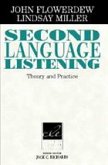Feedback in Second Language Writing
Herausgeber: Hyland, Ken; Hyland, Fiona
Feedback in Second Language Writing
Herausgeber: Hyland, Ken; Hyland, Fiona
- Gebundenes Buch
- Merkliste
- Auf die Merkliste
- Bewerten Bewerten
- Teilen
- Produkt teilen
- Produkterinnerung
- Produkterinnerung
Offers an up-to-date analysis of issues related to providing, using and researching feedback, including new developments in technology.
Andere Kunden interessierten sich auch für
![Noticing Oral Corrective Feedback in the Second Language Classroom Noticing Oral Corrective Feedback in the Second Language Classroom]() Eva KartchavaNoticing Oral Corrective Feedback in the Second Language Classroom44,99 €
Eva KartchavaNoticing Oral Corrective Feedback in the Second Language Classroom44,99 €![The Discourse of Teaching Practice Feedback The Discourse of Teaching Practice Feedback]() Fiona FarrThe Discourse of Teaching Practice Feedback47,99 €
Fiona FarrThe Discourse of Teaching Practice Feedback47,99 €![The Discourse of Teaching Practice Feedback The Discourse of Teaching Practice Feedback]() Fiona FarrThe Discourse of Teaching Practice Feedback115,99 €
Fiona FarrThe Discourse of Teaching Practice Feedback115,99 €![Teaching Second Language Academic Writing Teaching Second Language Academic Writing]() Christine M. TardyTeaching Second Language Academic Writing63,99 €
Christine M. TardyTeaching Second Language Academic Writing63,99 €![Investigating Plagiarism in Second Language Writing Investigating Plagiarism in Second Language Writing]() Jun LeiInvestigating Plagiarism in Second Language Writing63,99 €
Jun LeiInvestigating Plagiarism in Second Language Writing63,99 €![International L2 Students' Engagement with Teacher Feedback International L2 Students' Engagement with Teacher Feedback]() Fangfei LiInternational L2 Students' Engagement with Teacher Feedback169,99 €
Fangfei LiInternational L2 Students' Engagement with Teacher Feedback169,99 €![Second Language Listening Second Language Listening]() John FlowerdrewSecond Language Listening57,99 €
John FlowerdrewSecond Language Listening57,99 €-
-
-
Offers an up-to-date analysis of issues related to providing, using and researching feedback, including new developments in technology.
Produktdetails
- Produktdetails
- Verlag: Cambridge University Press
- Seitenzahl: 332
- Erscheinungstermin: 11. Juni 2019
- Englisch
- Abmessung: 235mm x 157mm x 22mm
- Gewicht: 633g
- ISBN-13: 9781108425070
- ISBN-10: 1108425070
- Artikelnr.: 55178909
- Herstellerkennzeichnung
- Libri GmbH
- Europaallee 1
- 36244 Bad Hersfeld
- gpsr@libri.de
- Verlag: Cambridge University Press
- Seitenzahl: 332
- Erscheinungstermin: 11. Juni 2019
- Englisch
- Abmessung: 235mm x 157mm x 22mm
- Gewicht: 633g
- ISBN-13: 9781108425070
- ISBN-10: 1108425070
- Artikelnr.: 55178909
- Herstellerkennzeichnung
- Libri GmbH
- Europaallee 1
- 36244 Bad Hersfeld
- gpsr@libri.de
Introduction. 1. Contexts and issues in feedback on L2 writing: setting the
scene Ken Hyland and Fiona Hyland; Part I. Situating Feedback:
Socio-cultural Dimensions: 2. Sociocultural theory: a framework for
understanding socio-cognitive dimensions of peer feedback Olga S. Villamil
and Maria C. M. de Guerrero; 3. Culture and peer feedback Guangwei Hu; 4.
Appropriation, ownership, and agency: negotiating teacher feedback in
academic settings Christine M. Tardy; Part II. Shaping Feedback: Delivery
and Focus Dimensions: 5. The intersection between SLA and feedback research
John Bitchener; 6. Does error feedback help L2 writers? Latest evidence on
the efficacy of written corrective feedback Dana Ferris and Kendon Kerzer;
7. Electronic resources for feedback Marie Stevenson and Aik Phakiti; 8.
Collaborative writing as peer feedback Neomy Storch; Part III. Negotiating
Feedback: Interpersonal and Interactional Dimensions: 9. Interpersonal
aspects of response: constructing and interpreting teacher written feedback
Ken Hyland and Fiona Hyland; 10. Fostering formative online forums:
feedback, dialogue and disciplinarity Ann Hewings and Caroline Coffin; 11.
Supervisory feedback: building writing scaffolds with doctoral students Sue
Starfield; 12. Reviewers' feedback on second language writers' submissions
to academic journals Brian Paltridge; Part IV. Engaging with Feedback:
Student Participation Dimensions: 13. Learner engagement with written
feedback from a socio-cognitive perspective Ye Han and Fiona Hyland; 14.
What messages do students take from teacher feedback? Ken Hyland; 15.
Students initiating feedback: the potential of social media Soobin Yim and
Mark Warschaeur; Index.
scene Ken Hyland and Fiona Hyland; Part I. Situating Feedback:
Socio-cultural Dimensions: 2. Sociocultural theory: a framework for
understanding socio-cognitive dimensions of peer feedback Olga S. Villamil
and Maria C. M. de Guerrero; 3. Culture and peer feedback Guangwei Hu; 4.
Appropriation, ownership, and agency: negotiating teacher feedback in
academic settings Christine M. Tardy; Part II. Shaping Feedback: Delivery
and Focus Dimensions: 5. The intersection between SLA and feedback research
John Bitchener; 6. Does error feedback help L2 writers? Latest evidence on
the efficacy of written corrective feedback Dana Ferris and Kendon Kerzer;
7. Electronic resources for feedback Marie Stevenson and Aik Phakiti; 8.
Collaborative writing as peer feedback Neomy Storch; Part III. Negotiating
Feedback: Interpersonal and Interactional Dimensions: 9. Interpersonal
aspects of response: constructing and interpreting teacher written feedback
Ken Hyland and Fiona Hyland; 10. Fostering formative online forums:
feedback, dialogue and disciplinarity Ann Hewings and Caroline Coffin; 11.
Supervisory feedback: building writing scaffolds with doctoral students Sue
Starfield; 12. Reviewers' feedback on second language writers' submissions
to academic journals Brian Paltridge; Part IV. Engaging with Feedback:
Student Participation Dimensions: 13. Learner engagement with written
feedback from a socio-cognitive perspective Ye Han and Fiona Hyland; 14.
What messages do students take from teacher feedback? Ken Hyland; 15.
Students initiating feedback: the potential of social media Soobin Yim and
Mark Warschaeur; Index.
Introduction. 1. Contexts and issues in feedback on L2 writing: setting the
scene Ken Hyland and Fiona Hyland; Part I. Situating Feedback:
Socio-cultural Dimensions: 2. Sociocultural theory: a framework for
understanding socio-cognitive dimensions of peer feedback Olga S. Villamil
and Maria C. M. de Guerrero; 3. Culture and peer feedback Guangwei Hu; 4.
Appropriation, ownership, and agency: negotiating teacher feedback in
academic settings Christine M. Tardy; Part II. Shaping Feedback: Delivery
and Focus Dimensions: 5. The intersection between SLA and feedback research
John Bitchener; 6. Does error feedback help L2 writers? Latest evidence on
the efficacy of written corrective feedback Dana Ferris and Kendon Kerzer;
7. Electronic resources for feedback Marie Stevenson and Aik Phakiti; 8.
Collaborative writing as peer feedback Neomy Storch; Part III. Negotiating
Feedback: Interpersonal and Interactional Dimensions: 9. Interpersonal
aspects of response: constructing and interpreting teacher written feedback
Ken Hyland and Fiona Hyland; 10. Fostering formative online forums:
feedback, dialogue and disciplinarity Ann Hewings and Caroline Coffin; 11.
Supervisory feedback: building writing scaffolds with doctoral students Sue
Starfield; 12. Reviewers' feedback on second language writers' submissions
to academic journals Brian Paltridge; Part IV. Engaging with Feedback:
Student Participation Dimensions: 13. Learner engagement with written
feedback from a socio-cognitive perspective Ye Han and Fiona Hyland; 14.
What messages do students take from teacher feedback? Ken Hyland; 15.
Students initiating feedback: the potential of social media Soobin Yim and
Mark Warschaeur; Index.
scene Ken Hyland and Fiona Hyland; Part I. Situating Feedback:
Socio-cultural Dimensions: 2. Sociocultural theory: a framework for
understanding socio-cognitive dimensions of peer feedback Olga S. Villamil
and Maria C. M. de Guerrero; 3. Culture and peer feedback Guangwei Hu; 4.
Appropriation, ownership, and agency: negotiating teacher feedback in
academic settings Christine M. Tardy; Part II. Shaping Feedback: Delivery
and Focus Dimensions: 5. The intersection between SLA and feedback research
John Bitchener; 6. Does error feedback help L2 writers? Latest evidence on
the efficacy of written corrective feedback Dana Ferris and Kendon Kerzer;
7. Electronic resources for feedback Marie Stevenson and Aik Phakiti; 8.
Collaborative writing as peer feedback Neomy Storch; Part III. Negotiating
Feedback: Interpersonal and Interactional Dimensions: 9. Interpersonal
aspects of response: constructing and interpreting teacher written feedback
Ken Hyland and Fiona Hyland; 10. Fostering formative online forums:
feedback, dialogue and disciplinarity Ann Hewings and Caroline Coffin; 11.
Supervisory feedback: building writing scaffolds with doctoral students Sue
Starfield; 12. Reviewers' feedback on second language writers' submissions
to academic journals Brian Paltridge; Part IV. Engaging with Feedback:
Student Participation Dimensions: 13. Learner engagement with written
feedback from a socio-cognitive perspective Ye Han and Fiona Hyland; 14.
What messages do students take from teacher feedback? Ken Hyland; 15.
Students initiating feedback: the potential of social media Soobin Yim and
Mark Warschaeur; Index.









